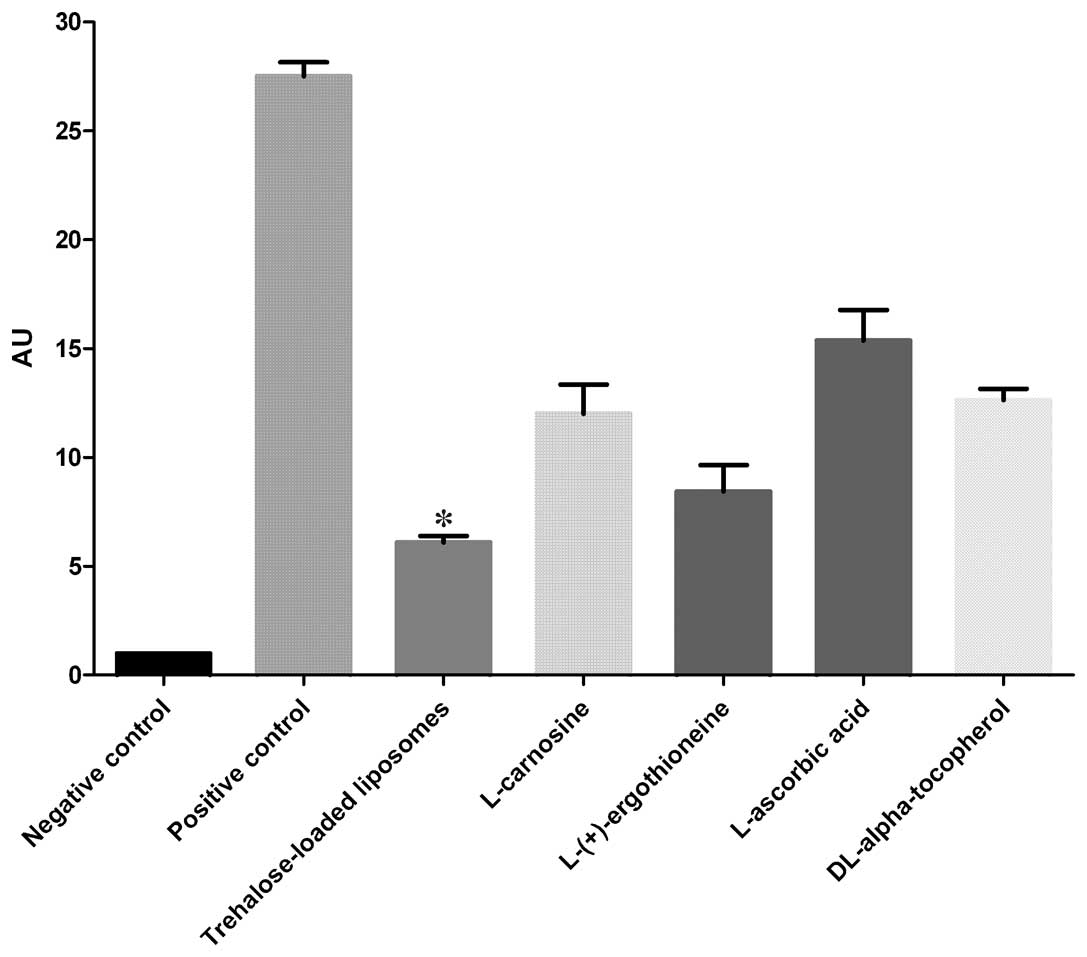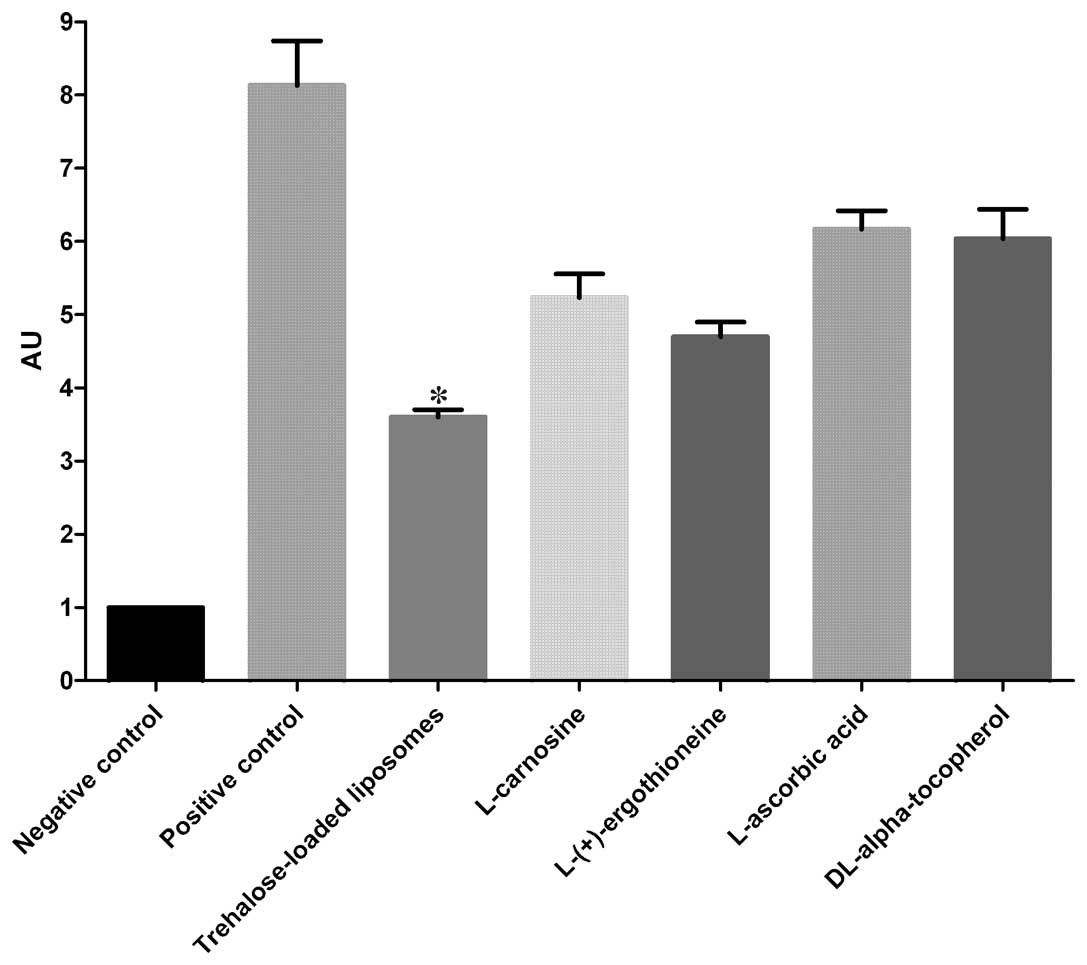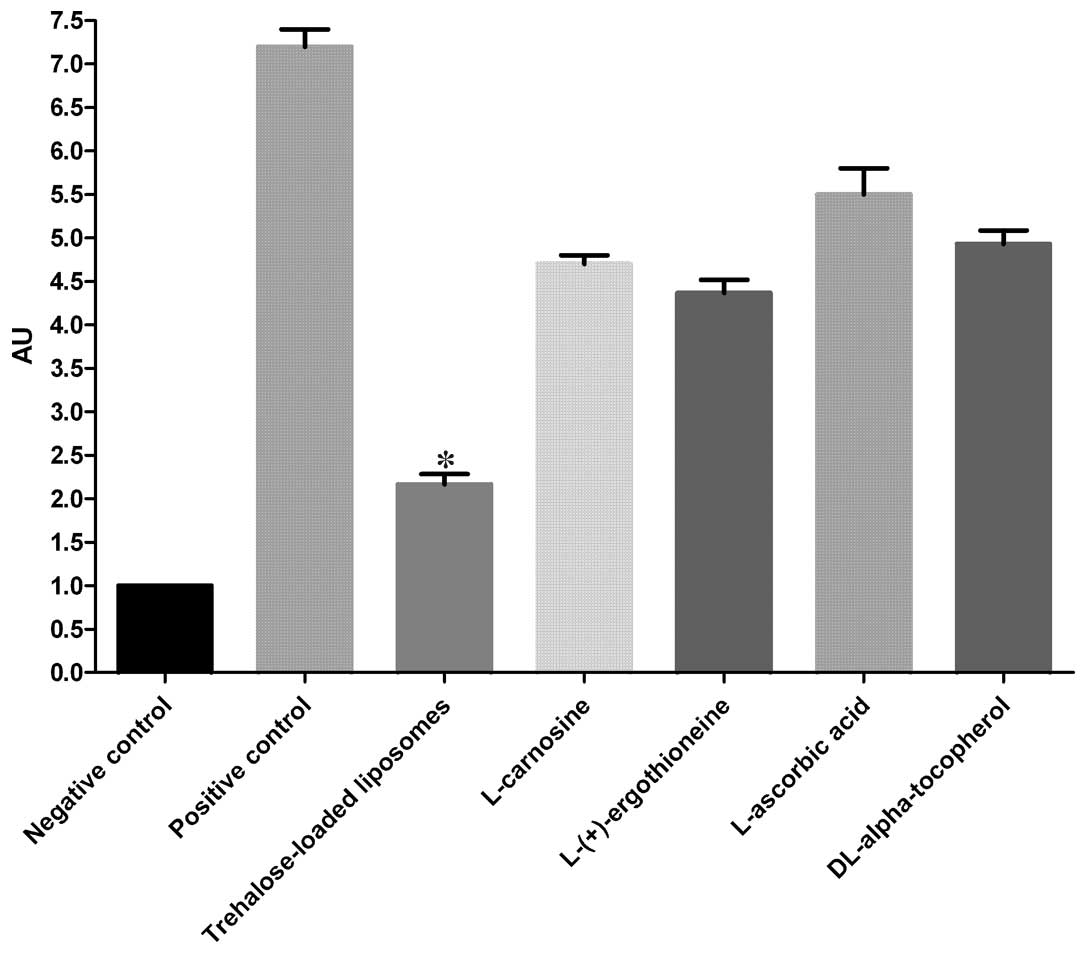|
1
|
D’Orazio J, Jarrett S, Amaro-Ortiz A and
Scott T: UV radiation and the skin. Int J Mol Sci. 14:12222–12248.
2013.
|
|
2
|
Mabruk MJ, Toh LK, Murphy M, Leader M, Kay
E and Murphy GM: Investigation of the effect of UV irradiation on
DNA damage: comparison between skin cancer patients and normal
volunteers. J Cutan Pathol. 36:760–765. 2009. View Article : Google Scholar : PubMed/NCBI
|
|
3
|
Chen AC, Halliday GM and Damian DL:
Non-melanoma skin cancer: carcinogenesis and chemoprevention.
Pathology. 45:331–341. 2013. View Article : Google Scholar : PubMed/NCBI
|
|
4
|
Marks R: Photoprotection and prevention of
melanoma. Eur J Dermatol. 9:406–412. 1999.PubMed/NCBI
|
|
5
|
Krutmann J and Schroeder P: Role of
mitochondria in photoaging of human skin: the defective powerhouse
model. J Investig Dermatol Symp Proc. 14:44–49. 2009. View Article : Google Scholar : PubMed/NCBI
|
|
6
|
Besaratinia A, Yoon JI, Schroeder C,
Bradforth SE, Cockburn M and Pfeifer GP: Wavelength dependence of
ultraviolet radiation-induced DNA damage as determined by laser
irradiation suggests that cyclobutane pyrimidine dimers are the
principal DNA lesions produced by terrestrial sunlight. FASEB J.
25:3079–3091. 2011. View Article : Google Scholar
|
|
7
|
Ichihashi M, Ueda M, Budiyanto A, et al:
UV-induced skin damage. Toxicology. 189:21–39. 2003. View Article : Google Scholar
|
|
8
|
Svobodova A, Walterova D and Vostalova J:
Ultraviolet light induced alteration to the skin. Biomed Pap Med
Fac Univ Palacky Olomouc Czech Repub. 150:25–38. 2006. View Article : Google Scholar : PubMed/NCBI
|
|
9
|
Kumar A, Pant MC, Singh HS and Khandelwal
S: Assessment of the redox profile and oxidative DNA damage
(8-OHdG) in squamous cell carcinoma of head and neck. J Cancer Res
Ther. 8:254–259. 2012. View Article : Google Scholar : PubMed/NCBI
|
|
10
|
Suzuki YJ, Carini M and Butterfield DA:
Protein carbonylation. Antioxid Redox Signal. 12:323–325. 2010.
View Article : Google Scholar : PubMed/NCBI
|
|
11
|
Bernerd F, Vioux C, Lejeune F and
Asselineau D: The sun protection factor (SPF) inadequately defines
broad spectrum photoprotection: demonstration using skin
reconstructed in vitro exposed to UVA, UVB or UV-solar simulated
radiation. Eur J Dermatol. 13:242–249. 2003.
|
|
12
|
Baliga MS and Katiyar SK: Chemoprevention
of photocarcinogenesis by selected dietary botanicals. Photochem
Photobiol Sci. 5:243–253. 2006. View
Article : Google Scholar : PubMed/NCBI
|
|
13
|
Yaar M and Gilchrest BA: Photoageing:
mechanism, prevention and therapy. Br J Dermatol. 157:874–887.
2007. View Article : Google Scholar : PubMed/NCBI
|
|
14
|
Afaq F and Mukhtar H: Botanical
antioxidants in the prevention of photocarcinogenesis and
photoaging. Exp Dermatol. 15:678–684. 2006. View Article : Google Scholar : PubMed/NCBI
|
|
15
|
Jurkiewicz BA, Bissett DL and Buettner GR:
Effect of topically applied tocopherol on ultraviolet
radiation-mediated free radical damage in skin. J Invest Dermatol.
104:484–488. 1995. View Article : Google Scholar : PubMed/NCBI
|
|
16
|
Cheah IK and Halliwell B: Ergothioneine;
antioxidant potential, physiological function and role in disease.
Biochim Biophys Acta. 1822.784–793. 2012.PubMed/NCBI
|
|
17
|
Lin JY, Selim MA, Shea CR, et al: UV
photoprotection by combination topical antioxidants vitamin C and
vitamin E. J Am Acad Dermatol. 48:866–874. 2003. View Article : Google Scholar : PubMed/NCBI
|
|
18
|
Paul BD and Snyder SH: The unusual amino
acid L-ergothioneine is a physiologic cytoprotectant. Cell Death
Differ. 17:1134–1140. 2010. View Article : Google Scholar : PubMed/NCBI
|
|
19
|
Emanuele E, Spencer JM and Braun M: From
DNA repair to proteome protection: new molecular insights for
preventing non-melanoma skin cancers and skin aging. J Drugs
Dermatol. 13:274–281. 2014.PubMed/NCBI
|
|
20
|
Wondrak GT: Redox-directed cancer
therapeutics: molecular mechanisms and opportunities. Antioxid
Redox Signal. 11:3013–3069. 2009. View Article : Google Scholar : PubMed/NCBI
|
|
21
|
Jain NK and Roy I: Effect of trehalose on
protein structure. Protein Sci. 18:24–36. 2009.PubMed/NCBI
|
|
22
|
Webb KM and DiRuggiero J: Role of
Mn2+and compatible solutes in the radiation resistance
of thermophilic bacteria and archaea. Archaea.
2012:8457562012.PubMed/NCBI
|
|
23
|
Ulrich AS: Biophysical aspects of using
liposomes as delivery vehicles. Biosci Rep. 22:129–150. 2002.
View Article : Google Scholar : PubMed/NCBI
|
|
24
|
Maalouf S, El-Sabban M, Darwiche N and
Gali-Muhtasib H: Protective effect of vitamin E on ultraviolet B
light-induced damage in keratinocytes. Mol Carcinog. 34:121–130.
2002. View
Article : Google Scholar : PubMed/NCBI
|
|
25
|
Kayasuga-Kariya Y, Iwanaga S, Fujisawa A,
et al: Dermal cell damage induced by topical application of
non-steroidal anti-inflammatory drugs is suppressed by trehalose
co-lyophilization in ex vivo analysis. J Vet Med Sci. 75:1619–1622.
2013. View Article : Google Scholar : PubMed/NCBI
|
|
26
|
Wei H, Ca Q, Rahn R, Zhang X, Wang Y and
Lebwohl M: DNA structural integrity and base composition affect
ultraviolet light-induced oxidative DNA damage. Biochemistry.
37:6485–6490. 1998. View Article : Google Scholar : PubMed/NCBI
|
|
27
|
Darr D, Combs S, Dunston S, Manning T and
Pinnell S: Topical vitamin C protects porcine skin from ultraviolet
radiation-induced damage. Br J Dermatol. 127:247–253. 1992.
View Article : Google Scholar : PubMed/NCBI
|
|
28
|
Placzek M, Gaube S, Kerkmann U, et al:
Ultraviolet B-induced DNA damage in human epidermis is modified by
the antioxidants ascorbic acid and D-alpha-tocopherol. J Invest
Dermatol. 124:304–307. 2005. View Article : Google Scholar : PubMed/NCBI
|
|
29
|
Njus D and Kelley PM: Vitamins C and E
donate single hydrogen atoms in vivo. FEBS Lett. 284:147–151. 1991.
View Article : Google Scholar : PubMed/NCBI
|
|
30
|
Shindo Y, Witt E, Han D, et al: Recovery
of antioxidants and reduction in lipid hydroperoxides in murine
epidermis and dermis after acute ultraviolet radiation exposure.
Photodermatol Photoimmunol Photomed. 10:183–191. 1994.PubMed/NCBI
|
|
31
|
Steenvoorden DP and van Henegouwen GM: The
use of endogenous antioxidants to improve photoprotection. J
Photochem Photobiol B. 41:1–10. 1997. View Article : Google Scholar : PubMed/NCBI
|
|
32
|
Lin FH, Lin JY, Gupta RD, et al: Ferulic
acid stabilizes a solution of vitamins C and E and doubles its
photoprotection of skin. J Invest Dermatol. 125:826–832. 2005.
View Article : Google Scholar : PubMed/NCBI
|
|
33
|
Murray JC, Burch JA, Streilein RD,
Iannacchione MA, Hall RP and Pinnell SR: A topical antioxidant
solution containing vitamins C and E stabilized by ferulic acid
provides protection for human skin against damage caused by
ultraviolet irradiation. J Am Acad Dermatol. 59:418–425. 2008.
View Article : Google Scholar
|
|
34
|
Césarini JP, Michel L, Maurette JM,
Adhoute H and Béjot M: Immediate effects of UV radiation on the
skin: modification by an antioxidant complex containing
carotenoids. Photodermatol Photoimmunol Photomed. 19:182–189.
2003.PubMed/NCBI
|
|
35
|
Ichihashi M, Funasaka Y, Ohashi A, et al:
The inhibitory effect of DL-alpha-tocopheryl ferulate in lecithin
on melanogenesis. Anticancer Res. 19:3769–3774. 1999.PubMed/NCBI
|
|
36
|
McVean M and Liebler DC: Prevention of DNA
photodamage by vitamin E compounds and sunscreens: roles of
ultraviolet absorbance and cellular uptake. Mol Carcinog.
24:169–176. 1999. View Article : Google Scholar : PubMed/NCBI
|
|
37
|
Zhu BZ, Mao L, Fan RM, et al:
Ergothioneine prevents copper-induced oxidative damage to DNA and
protein by forming a redox-inactive ergothioneine-copper complex.
Chem Res Toxicol. 24:30–34. 2011. View Article : Google Scholar : PubMed/NCBI
|
|
38
|
Markova NG, Karaman-Jurukovska N, Dong KK,
Damaghi N, Smiles KA and Yarosh DB: Skin cells and tissue are
capable of using L-ergothioneine as an integral component of their
antioxidant defense system. Free Radic Biol Med. 46:1168–1176.
2009. View Article : Google Scholar : PubMed/NCBI
|
|
39
|
Reeve VE, Bosnic M and Rozinova E:
Carnosine (beta-alanylhistidine) protects from the suppression of
contact hypersensitivity by ultraviolet B (280–320 nm) radiation or
by cis urocanic acid. Immunology. 78:99–104. 1993.PubMed/NCBI
|
|
40
|
Emanuele E: Challenging the central dogma
of skin photobiology: are proteins more important than DNA? J
Invest Dermatol. 134:2052–2053. 2014. View Article : Google Scholar : PubMed/NCBI
|













